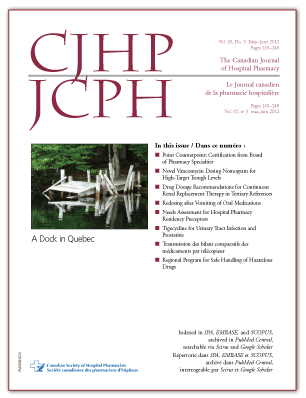Presence and Accuracy of Drug Dosage Recommendations for Continuous Renal Replacement Therapy in Tertiary Drug Information References
DOI:
https://doi.org/10.4212/cjhp.v65i3.1141Keywords:
renal failure, continuous renal replacement therapy, dosage adjustments, drug information, insuffisance rénale, traitement continu de remplacement de la fonction rénale, ajustements posologiques, information sur les médicamentsAbstract
ABSTRACT
Background: Clinicians commonly rely on tertiary drug information references to guide drug dosages for patients who are receiving continuous renal replacement therapy (CRRT). It is unknown whether the dosage recommendations in these frequently used references reflect the most current evidence.
Objective: To determine the presence and accuracy of drug dosage recommendations for patients undergoing CRRT in 4 drug information references.
Methods: Medications commonly prescribed during CRRT were identified from an institutional medication inventory database, and evidence-based dosage recommendations for this setting were developed from the primary and secondary literature. The American Hospital Formulary System—Drug Information (AHFS–DI), Micromedex 2.0 (specifically the DRUGDEX and Martindale databases), and the 5th edition of Drug Prescribing in Renal Failure (DPRF5) were assessed for the presence of drug dosage recommendations in the CRRT setting. The dosage recommendations in these tertiary references were compared with the recommendations derived from the primary and secondary literature to determine concordance.
Results: Evidence-based drug dosage recommendations were developed for 33 medications administered in patients undergoing CRRT. The AHFS–DI provided no dosage recommendations specific to CRRT, whereas the DPRF5 provided recommendations for 27 (82%) of the medications and the Micromedex 2.0 application for 20 (61%) (13 [39%] in the DRUGDEX database and 16 [48%] in the Martindale database, with 9 medications covered by both). The dosage recommendations were in concordance with evidence-based recommendations for 12 (92%) of the 13 medications in the DRUGDEX database, 26 (96%) of the 27 in the DPRF5, and all 16 (100%) of those in the Martindale database.
Conclusions: One prominent tertiary drug information resource provided no drug dosage recommendations for patients undergoing CRRT. However, 2 of the databases in an Internet-based medical information application and the latest edition of a renal specialty drug information resource provided recommendations for a majority of the medications investigated. Most dosage recommendations were similar to those derived from the primary and secondary literature. The most recent edition of the DPRF is the preferred source of information when prescribing dosage regimens for patients receiving CRRT.
RÉSUMÉ
Contexte : Les cliniciens s’appuient couramment sur des sources tertiaires d’information pour guider les posologies médicamenteuses chez les patients sous traitement continu de remplacement de la fonction rénale (TCRFR). On ignore si les recommandations posologiques dans ces sources couramment utilisées reflètent les données probantes les plus actuelles.
Objectif : Déterminer la présence et l’exactitude des recommandations sur la posologie des médicaments utilisés chez les patients sous TCRFR dans quatre sources d’information sur les médicaments.
Méthodes : On a dressé la liste des médicaments couramment prescrits durant le TCRFR à partir d’une base de données des médicaments en inventaire dans un établissement, puis on a défini des recommandations posologiques fondées sur des données probantes issues de la literature primaire et secondaire. L’American Hospital Formulary System—Drug Information (AHFS–DI), le Micromedex 2.0 (en particulier les bases de données DRUGDEX et Martindale) et la 5e édition de Drug Prescribing in Renal Failure (DPRF5) ont été évalués à la recherche de recommandations posologiques sur des médicaments utilisés en cours de TCRFR. Les recommandations posologiques dans ces sources tertiaires ont été comparées aux recommandations tirées de la littérature primaire et secondaire pour établir une concordance.
Résultats : Des recommandations posologiques fondées sur des données probantes ont été rédigées pour 33 médicaments administrés aux patients sous TCRFR. L’AHFS–DI n’a fourni aucune recommendation posologique spécifique au contexte du TCRFR, alors que la DPRF5 a fourni des recommandations posologiques pour 27 (82%) des médicaments et le logiciel d’application Micromedex 2.0 pour 20 (61%) des médicaments (13 [39%] dans la base de données DRUGDEX et 16 [48%] dans la base de données Martindale, dont 9 médicaments traits dans les deux sources). Les recommandations posologiques concordaient avec celles fondées sur des données probantes pour 12 (92%) des 13 médicaments de la base de données DRUGDEX, 26 (96%) des 27 médicaments de la DPRF5 et tous les 16 médicaments (100%) de la base de données Martindale.
Conclusions : Une importante source tertiaire d’information sur les médicaments n’a fourni aucune recommandation posologique sur des médicaments utilisés chez les patients sous TCRFR. En revanche, deux des bases de données comprises dans une application Web d’information médicale et la dernière édition d’une source d’information sur les médicaments utilisés en néphrologie ont fourni des recommandations pour la majorité des médicaments examinés. La plupart des recommandations posologiques étaient similaires à celles tirées des sources d’information primaires et secondaires. La plus récente édition du DPRF est la source préférée pour l’établissement des schemas posologiques chez les patients qui reçoivent un TCRFR.
Downloads
Published
Issue
Section
License
Copyright © Canadian Society of Healthcare-Systems Pharmacy.
After publication of a manuscript in the CJHP, the authors of the manuscript must obtain written permission from the CSHP (publications@cshp.ca) before reproducing any text, figures, tables, or illustrations from the work in future works of their own. If a submitted manuscript is declined for publication in the CJHP, all said rights shall revert to the authors. Please note that any forms (e.g., preprinted orders and patient intake forms) used by a specific hospital or other health care facility and included as illustrative material with a manuscript are exempt from this copyright transfer. The CJHP will require a letter from the hospital or health care facility granting permission to publish the document(s).










